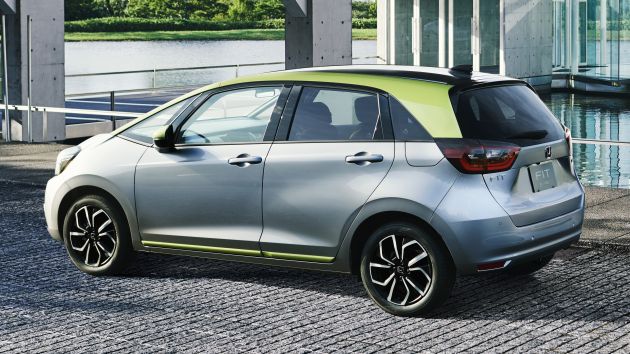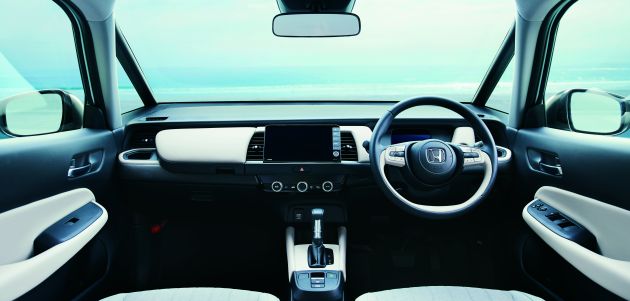Following on from this morning’s news, Honda has confirmed that the new fourth-generation Jazz will go on sale tomorrow in Japan, where it will be called the Fit. Unlike in Europe, where the B-segment hatch will only be available as an e:HEV hybrid, the car will also be offered in its home market with a petrol engine.
The engine in question is a 1.3 litre naturally-aspirated i-VTEC four-cylinder, making 98 PS at 6,000 rpm and 118 Nm of torque at 5,000 rpm. As before, it’s mated to a CVT and a choice of either front or four-wheel drive, delivering a fuel consumption figure of 20.4 km per litre on the WLTP cycle (18.2 km per litre with 4WD).
It will be offered alongside Honda’s Intelligent Multi-Mode Drive hybrid system, which replaces the previous Intelligent Dual Clutch Drive (i-DCD) setup. A downsized version of the one in the Accord Hybrid, it utilises a 1.5 litre mill that on its own makes 98 PS from 5,600 to 6,400 rpm and 127 Nm from 4,500 to 5,000 rpm. This is paired to an electric motor, which acts as a generator to charge the lithium-ion battery.
Another motor does most of the heavy lifting of driving the wheels, making 80 kW (109 PS) and 253 Nm. Unlike in other hybrid cars, the petrol engine functions as a range extender of sorts, and only at higher speeds is it linked directly to the wheels, via a single-speed transmission and a lock-up clutch. The electric propulsion motor can also drive the wheels on its own, of course, using power stored in the battery.
Honda says this setup provides a smoother transfer of torque and a linear feel during acceleration, whilst also being more compact and refined compared to the planetary gear sets found in other hybrids. It is capable of getting from zero to 100 km/h in 9.4 seconds before reaching a top speed of 175 km/h, while its combined fuel consumption is rated at 28.8 km per litre, or 25.2 km per litre with four-wheel drive.
According to the company, the new Jazz was designed with comfort in mind, particularly on the inside. To that end, it has leaned harder on its “man maximum, machine minimum” philosophy, using the more compact powertrain to provide increased interior space and laying out the car’s storage compartments with careful consideration of the customer’s use habits. The addition of a “table console” between the front seats, onto which a handbag or other items can be placed, is one such example of the latter.
The front seats have also been re-profiled with a more “body stabilising” design that supports the pelvis and lumbar spine using a resin mat – a Honda first – while the rear seats feature thicker and softer padding for increased comfort even for adults. Under the skin, the body structure has been made lighter and more rigid, and the suspension has been retuned to absorb impacts more quickly, making for a flatter ride.
Meanwhile, the A-pillars’ cross-sectional structure has been redesigned to reduce their thickness to less than half that of previous models, without compromising safety. This, combined with the use of a flat dashboard and a visor-less instrument display, provides the driver with a better view of their surroundings.
As revealed during its Tokyo world premiere last year, the Jazz will be sold in Japan in five flavours, including the base, um, Basic, the slightly more upmarket Home and the range-topping Luxe, the latter getting chrome accents and genuine leather upholstery. Those of a more lifestyle bent can opt for the Ness (Fit Ness, geddit?) and the SUV-style Crosstar, both of which are offered with water-repellant fabric trim.
The Jazz will also come as standard with a suite of Honda Sensing driver assistance systems, which include autonomous emergency braking (with short distance and pedestrian detection functions), all-speed adaptive cruise control, lane keeping assist, traffic sign recognition, auto high beam, front and rear pedal misapplication control and a front departure alert.
Last but not least, the Jazz will be the first car sold in Japan to be offered with Honda Connect services, under the Honda Total Care Premium pack. This include an emergency call function and the ability to lock, unlock and control the car’s air-conditioning remotely.
Source: Read Full Article




